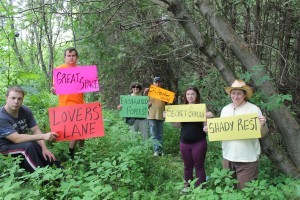A Walk in the Park Improves Attention
By Francine St.Amand
Most people would agree that being in a natural setting is relaxing and refreshing. The effect that nature has on our minds has been the subject of psychology research for a least a century and more intensely in the last few decades. This brain/nature connection is something that is increasingly catching the attention of city planners, teachers, parents and anyone looking for ways to reduce stress and improve brain function. And with so many children being diagnosed with various attention disorders – there is much to be gained from a remedy that may be right in our own backyard.

Enchanted Forest during a recent Walk in the Park
Numerous studies have proven what we already instinctively know – that exposure to nature is good for our mental fitness.
“The future will belong to the nature-smart—those individuals, families, businesses, and political leaders who develop a deeper understanding of the transformative power of the natural world and who balance the virtual with the real. The more high-tech we become, the more nature we need.”
—RICHARD LOUV
A couple of weeks ago, a posting came up on facebook about the Down-by-the-Brook Forest Preschool which was recently launched in Fredericton. It is a joint venture between the Fredericton Family Resource Centre and the Conservation Council of New Brunswick and other partners.
The reference to “No Child Left Inside” in this initiative got my attention. I googled it and BINGO! There, I found out about Richard Louv who coined the term Nature Deficit Disorder in his book, Last Child in the Woods: Saving Our Children From Nature-Deficit Disorder (2005). This is not an actual psychiatric disorder but the term makes the point that children’s lack of exposure to the outdoors is actually making other disorders more prevalent.
Louv didn’t come up with his conclusions out of the blue. American psychologist, William James, got the ball rolling on the nature/brain connection with his Attention Restoration Theory in 1892. The basic premise to his theory is that too much directed, effortful attention (which is the mode our brains are in for most of our waking hours) leads to brain fatigue. Conversely, involuntary, effortless attention helps to restore/reset the brain so that it can improve the quality for focused attention. He concluded that being exposed to natural environments allows our brains to experience involuntary, effortless attention. And when you brain takes a break in this way, it helps restore cognitive and memory function. ..AND ….CREATIVITY!!!
And then came Stephen and Rachel Kaplan.
“Rachel and Stephen Kaplan are professors of psychology at the University of Michigan, specializing in environmental psychology. The Kaplans are known for their research on the effect of nature on people’s relationships and health. Their work on “restorative environments” and Attention Restoration Theory has impacted how landscape and design professionals and others view humanity’s relationship with nature. The Kaplans got involved in studying the effects of nature on people back in the 1970s with a US Forest Service grant to evaluate a challenge program in Michigan’s wilderness. This introduction went on to influence generations of environmental psychologists and designers.
The Kaplans have found that too much focused attention on anything can lead to mental fatigue and such fatigue’s remedy is found in exposure to nature. In order for nature to best work its relaxing effect it is preferable for a place to have a high fascination value. An environment that automatically pulls the viewer into it is most beneficial. The Kaplan’s research has found that office workers with a view of nature were happier and healthier at work (Kaplan 1993). Exposure to natural environments of the most mundane sort has proven to lift people’s moods and enhance their ability to mentally focus.” ~ Wikipedia
In the past decade, Richard Louv, put the focus of nature/brain connection on school-age children. His work was the catalyst for the No Child Left Inside movement and subsequently, a number of outdoor learning programs geared for school children have been created.
Louv’s work investigates the relationship of children and the natural world in current and historical contexts. Louv created the term “nature-deficit disorder” to describe possible negative consequences to individual health and the social fabric as children move indoors and away from physical contact with the natural world – particularly unstructured, solitary experience. Louv cites research pointing to attention disorders, obesity, a dampening of creativity and depression as problems associated with a nature-deficient childhood. He amassed information on the subject from practitioners of many disciplines to make his case, and is commonly credited with helping to inspire an international movement to reintroduce children to nature” ~ Wikipedia
Perth-Andover is in a very good position to repurpose some of the flood-prone areas to BE a restorative environment for the local community and visitors. Projects like Forest Schools and Outdoor Classrooms are very feasible and the benefits to a child’s learning experience is obvious and well documented.
Please join in on the Walk In The Park which is being held on every Sunday throughout August and September and see for yourself how a little bit of nature can reset your brain. Meet up time is 2:00pm at the Bandstand in Andover.
